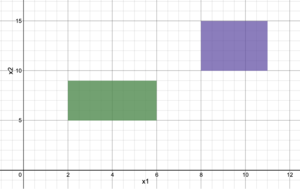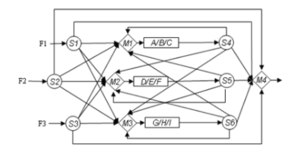Disjunctive inequalities
Authors: Derek Moore, Grant Logan, Matthew Dinh, Daniel Ladron (SYSEN 5800/CHEME 6800 Fall 2021)
Introduction
Disjunctive inequalities are a form of disjunctive constraints that can be applied to linear programming. Disjunctive constraints are applied in all disjunctive programming, which just refers to the use of logical constraints in linear inequalities, which include “Or,” And,” or "Complement of" statements.[1] In order to solve a disjunctive, the constraints have to be converted into mixed-integer programming (MIP) or mixed-inter linear programming (MILP) constraints, which is called disjunction. Disjunction involves the implementation of a binary variable to create a new set of constraints that can be solved easily. Two common methods for disjunction are the Big-M Reformulation and the Convex-Hull Reformulation.[2]
Method
General
When given a set of inequalities, such as , the disjunctive form is given by: [1] In order to turn the problem into a solvable MIP or MILP, logical constraints are created by using sufficiently large numbers, such as and , and a binary variable y for each inequality. This is shown below by , , and :
To set the binary variable to be mutually exclusive, the sum of the variables is set to 1 and the range is set to {0,1}.
Big-M Reformulation[1][2]

For the Big-M reformulation, a sufficiently large number, , is used to nullify one set of constraints. This is accomplished by adding or subtracting the term “” to the upper bound and lower bound constraints, respectively, with its respective binary variable. While choosing a large M value allows for isolation, the large value also yields poor relaxation of the model space.[3]
For example, given a solution space (shown graphically in Figure 1), to determine which of the solutions is optimal, the problem must be formulated such that one set of constraints is chosen. Using the Big-M Reformulation, the following MILP set would be obtained:
y Formulation
-y Formulation
Convex-Hull Reformulation[1][2]
Similar to the Big-M reformulation, the convex-hull reformulation uses a binary variable, y, to constrain the set of inequalities. The first step in converting the problem into a solvable MILP is breaking all variables into a set of variables, such as ( → + ). By adding these addition variables, it is possible to isolate what set of parameters provide for the optimal solution of the problem. Then, similar to the Big-M reformulation, a sufficiently large variable, M, is used to nullify the non-optimal variable set, such as and . For the problem show in Figure 1, the following variable constraints would be formulated:
y Formulation
-y Formulation
Formulation of the numerical constraints would then be implemented:
y Formulation
-y Formulation
With the Convex-Hull transformation, the additional constraints confine the problem, such that a tighter (convex) solution space is examined compared to Big-M Formulation.[3]
Examples
Example 1: Location for a Farmers Market
An example of a disjunctive inequality that involves m possible locations for a farmers market and n customers who would like to purchase produce from those farmers. This is convenient for customers who want to purchase produces from local farmers. There is a fixed cost to supplying each farmers market with produce from local farmers as well as a capacity. There are also demands from customers on what produces they want. The following formulation of disjunctive inequalities can be used to determine why a farmers market is needed at location for customers .
is the capacity of the transportation from farmer market i to customer j
is the number of produced bought by the customer j from the farmer market i
is the amount of purchases at farmer markets i
is the fixed cost for farmers market i
is the capacity amount of farmer markets i
is the fixed cost for transportation from farmers market i to customer j
Redefining this problem into a Convex Hull form requires defining binary variables involved with each case and setting their summation to 1. For new variables derived from the original variables are created for use in each case.
Now nullify the non-optimal variable sets with a large M:
The number of produce shipped to a farmers market is constraint by due to the capacity of produce the farmer market can hold. The number produce shipped is also constraint by it's own capacity that it can hold during the transportation process.
The total cost will be greater than the sum of the fixed cost of the farmers market and the capacity of the farmers market.
Thus, the result is there cannot be a farmers market at this location of
Finally, the farmers market can be located in this location of for
,
Applications

Disjunctive inequality programming can be used to solve real world problems in various sectors. Integer programming formulations utilizing a binary decision variable on which multiple constraints depend can be reformulated into disjunctive inequality formulations.
Strip Packing Problem
The Strip Packing Problem is a well-known problem in which two dimensional rectangles, or strips, are aligned in a two dimensional grid, with a variety of possible objectives, subject to the constraints that the strips do not overlap. One method of formulating this problem is to describe the non-overlapping constraints as a set of four statements: for an existing rectangle , a new rectangle must be above, below, to the left, or to the right of rectangle . Each situation represents a unique inequality constraint; for example, if is above , then it must hold that the lower border of is at a greater value than the lower border of plus the height of . This can be extended to remove symmetries and improve efficiency of the solutions as well[4].
Process Scheduling
In process scheduling, machine and shop floor operations are scheduled in such a way to maximize production of a final product. Many of the decisions underlying these operations are binary: whether or not to run a machine/operation at a given time. If a machine/operation is run, constraints are required to define costs, profits, and resources associated with the running machine/operation. If a machine/operation is not run, a different set of constraints is required to define idle costs and resources. This can be formulated into a disjunctive inequality formulation and solved using the described methods.
Figure 2 shows a special case of process scheduling, a wastewater network that removes pollutants from its mixture. The task is to figure out the total cost to discharge the pollution.[5]
This wastewater system can be reformulated into a non-convex General Disjunction Programming problem shown below:[5]
{True, False}
Conclusion
As shown, disjunctive inequalities can be used to generate all valid inequalities for an integer program. A simple disjunctive procedure can be used to generate all valid inequalities for a 0 or 1 mixed-integer program. Two methods that are used to reformulate the problem are Convex Hull and Big-M formulations. It could be shown that to obtain the convex hull of a 0 or 1 mixed-integer program, it suffices to take the convex hull of each 0 or 1 variable at a time [3]. Implementing the Big-M method generates a much smaller MILP/MINLP with a tighter relaxation than the convex-hull method. Disjunctive inequalities can be used to improve the performance of any general purpose Branch-and-Cut algorithm as shown on the research from Balas and Bonami [6]. Most of the real world problems that can be solved through disjunctive inequalities are in chemical engineering or involve process synthesis where a logic decision has to be made to optimize the solution.
References
- ↑ 1.0 1.1 1.2 1.3 E. Balas, “Disjunctive programming,” Annals of Discr. Math., vol. 5, pp. 6-11, 1979.
- ↑ 2.0 2.1 2.2 Pedro M. Castro and Ignacio E. Grossmann. 'Generalized Disjunctive Programming as a Systematic Modeling Framework to Derive Scheduling Formulations." 2012 51 (16), 5781-5792 DOI: 10.1021/ie2030486
- ↑ 3.0 3.1 3.2 You, Frengqi. (2021). "Mixed-Integer Linear Programming."
- ↑ Trespalacios, Francisco, and Ignacio E. Grossmann. "Symmetry breaking for generalized disjunctive programming formulation of the strip packing problem." Annals of Operations Research 258, no. 2 (2017): 747-759.
- ↑ 5.0 5.1 Grossmann, Ignacio E., and Juan P. Ruiz. Generalized Disjunctive Programming: A framework for formulation and alternative algorithms for MINLP optimization, Mixed Integer Nonlinear Programming, Springer New York, 2012.
- ↑ E. Balas, P. Bonami. "Generating lift-and-project cuts from the LP simplex tableau: open source implementation and testing of new variants. Math. Prog. Comp. 1", 165–199 (2009)










































































